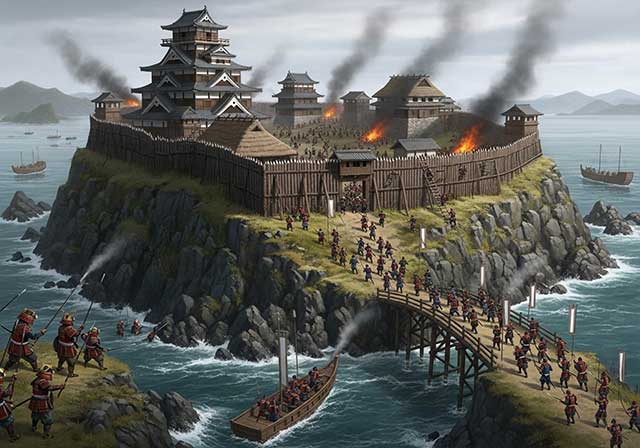
Hojo Nagauji (Soun) (1432–1519) went down in Japanese history as one of the most notable figures of his time. He is considered a prime example of a gokoku-jo daimyo. The process of gokoku-jo literally means “the lower classes defeat the upper classes” and in Japanese history was expressed, among other things, in the elevation of minor samurai to the status of owners of entire provinces.
Sou's origins remain unclear. There is a suggestion that he may have been associated with the Heiji clan of Ise, as he was initially named Ise Moritoki, and later Ise Shinkuro. He later married his son Ujitsuna to a girl from the noble Hojo family and took this ancient surname for himself.
First steps in the military arena
During the Onin War, around 1475, Hojo Nagauji fled to Suruga Province and entered the service of his relative, Imagawa Yoshitada. After Yoshitada's death in 1476, a fierce family feud began. In this struggle, Shinkuro supported his nephew Yoshitaka, who, in gratitude, granted him Kokokuji Castle, a detachment of samurai, and the right to use a character from his own name.
Now, the former novice Shinkuro, under the name of Ise Nagauji, became a close associate of one of the most powerful feudal lords and was appointed commandant of the castle.
Acquisition of the province of Izu
In 1490, Nagauji had an opportunity to advance even further. In the neighboring province of Izu, Ashikaga Tadamaru, the son of the local daimyo, killed his father, mother, and younger brother, who had been designated as heir. Seeing the rebellion as a chance to prove himself, Nagauji surrounded the patricide with his own troops at Horigoe Castle, where he committed suicide. The Ashikaga vassals recognized Nagauji's authority, and thus he inherited the entire province of Izu.
Conquest of Sagami
In 1494, Nagauji launched a new offensive. He captured the main fortress of Sagami Province, Odawara Castle. However, he failed to completely subjugate the province. The Miura clan, which occupied the peninsula of the same name near Kamakura, the former capital of the shogunate, remained a serious obstacle.
Japanese history had already seen an example of confrontation between the Hojo and Miura clans, although at that time it was a different Hojo and a different Miura. At one time, the Miura clan helped Minamoto no Yoritomo establish the first Kamakura shogunate. But later, after Yoritomo's death, the Hojo clan, which seized power in the country, brutally dealt with its former allies, defeating Miura in 1247. Nevertheless, over time, Miura revived and continued to rule the territories on the peninsula of the same name.
The personality of Miura Yoshiatsu
At the beginning of the 16th century, the Miura clan was ruled by Miura Yoshiatsu, also an extraordinary man. His biological father was Uesugi Takamasa, but at an early age he was adopted by his uncle, the daimyo Miura Tokitaka.
However, in 1496, when Tokitaka had a son of his own, he decided to deprive Yoshiatsu of his inheritance and send him to a monastery. Yoshiatsu did not accept this and rebelled. At night, he suddenly attacked Tokitaka at Arai Castle, killing his adoptive father and his son. He handed over Arai Castle to his own son, Miura Yoshimoto, and chose Okazaki Castle as his own base.
Alliances and conflicts
Thanks to his family ties, Yoshiatsu was allied with the Ogigayatsu branch of the Uesugi clan. Together with his son, he did everything in his power to prevent the Hojo clan from expanding its influence in Sagami Province. However, luck turned against him: his attempts to capture the Hojo's forward fortifications failed. In addition, internal conflicts broke out within the Uesugi clan, and the Hojo were able to concentrate all their forces on fighting the Miura.
Siege of Arai Castle
In September 1512, Hojo Soon took decisive action. He prepared to lay siege to Okazaki Castle, the main stronghold of the Miura clan and a key fort in the defense of the peninsula. Yoshiatsu was forced to abandon it and take refuge in Arai Castle, whose defense was led by his son Yoshimoto.
Several skirmishes took place between the Miura and Hojo forces near Kamakura. Sou's warriors managed to capture a number of auxiliary shijo forts, finally trapping Miura in Arai Castle.
Araki Fortress
Araki Castle was a typical 15th-century fortress. It did not yet have stone walls, powerful towers, or deep moats filled with water. However, for its time, the fortifications were considered quite advanced. The castle occupied a small peninsula with rocky shores that provided natural protection.
The part of the land connecting the peninsula to the mainland was blocked by a moat, across which a drawbridge is believed to have passed. There were several courtyards in Arai — defensive lines reinforced with earthen ramparts, dry moats, palisades, and stockades. The castle also had observation towers.
A long siege
Hojo Soun decided not to storm the castle immediately. He blockaded the fortress and waited, hoping that hunger would eventually take its toll on the defenders. Sources do not clearly indicate whether Souon managed to completely cut off maritime communication. Most likely, the blockade remained partial, because the defenders were able to hold out for about three years.
The assault and demise of the Miura clan
In 1516, Soun finally gave the order for a massive assault on Arai Castle. The attack was carried out simultaneously from land, across a large moat, and from the sea, with the help of a landing force on boats.
The exhausted but steadfast defenders fought bravely. However, the forces were unequal. Hojo's warriors first managed to break through the outer lines of defense and then capture the main complex of the fortress deep inside the peninsula.
Both leaders of the Miura clan, father and son, committed suicide. According to legend, Yoshimoto did so in an unusual way — he cut off his own head. It is difficult to say whether this is true or not, but sources mention that this act made a strong impression on Hojo Souna.
See also
-
The Siege of Hara Castle

The Shimabara Rebellion of 1637–1638, which culminated in the siege of Hara Castle, was the last major uprising of the Edo period and had serious political consequences.
-
Battle of Tennoji

The confrontation between Tokugawa Ieyasu and Toyotomi Hideyori during the “Osaka Winter Campaign” ended with the signing of a peace treaty. On January 22, 1615, the day after the treaty was signed, Ieyasu pretended to disband his army. In reality, this meant that the Shimazu forces withdrew to the nearest port. On the same day, almost the entire Tokugawa army began filling in the outer moat.
-
Siege of Shuri Castle

The Ryukyu Kingdom was established in 1429 on Okinawa, the largest island of the Ryukyu (Nansei) archipelago, as a result of the military unification of three rival kingdoms. In the following years, the state's control spread to all the islands of the archipelago.
-
The Siege of Fushimi Castle
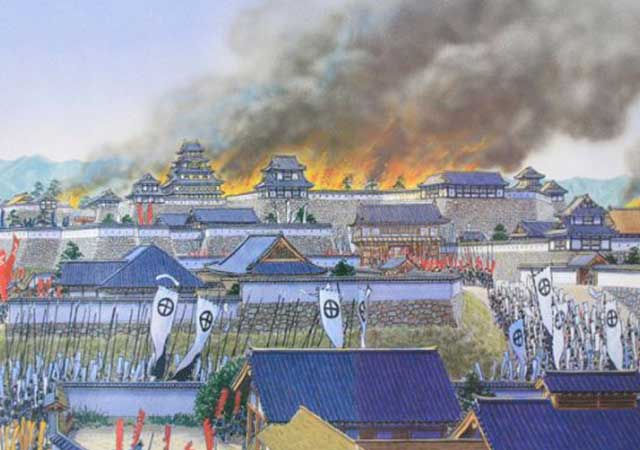
Fushimi can perhaps be considered one of the most “unfortunate” castles of the Sengoku Jidai period. The original castle was built by Toyotomi Hideyoshi in the southeast of Kyoto in 1594 as his residence in the imperial city.
-
The Siege of Otsu Castle
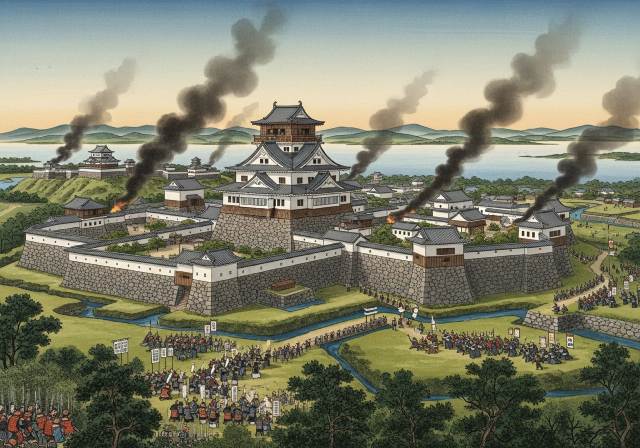
The siege of Otsu Castle was part of the Sekigahara campaign, during which the so-called Eastern Coalition, led by Tokugawa Ieyasu, fought against the Western Coalition, led by Ishida Mitsunari. Otsu Castle was built in 1586 by order of Toyotomi Hideyoshi near the capital Kyoto, on the site of the dismantled Sakamoto Castle. It belonged to the type of “water castles” — mizujō — as one side of it faced Japan's largest lake, Lake Biwa, and it was surrounded by a system of moats filled with lake water, which made the fortress resemble an island.
-
The Siege of Shiroishi Castle
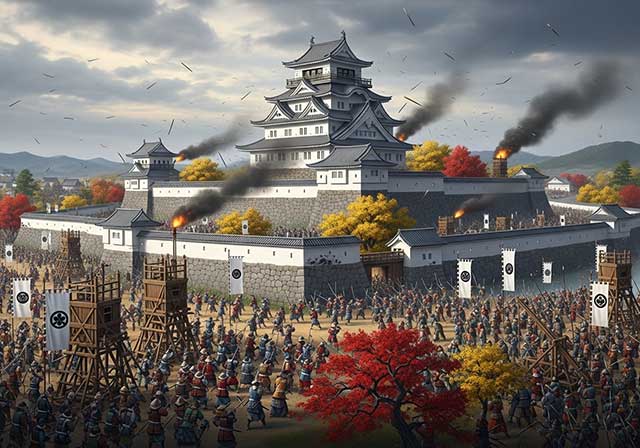
The siege of Shiroishi Castle was part of the Sekigahara campaign and took place several months before the decisive battle of Sekigahara. The daimyo of Aizu Province, Uesugi Kagekatsu, posed a serious threat to Tokugawa Ieyasu's plans to defeat the Western Coalition, and Ieyasu decided to curb his actions with the help of his northern vassals. To this end, he ordered Date Masamune to invade the province of Aizu and capture Shiroishi Castle.
-
The Second Siege of Jinju Castle
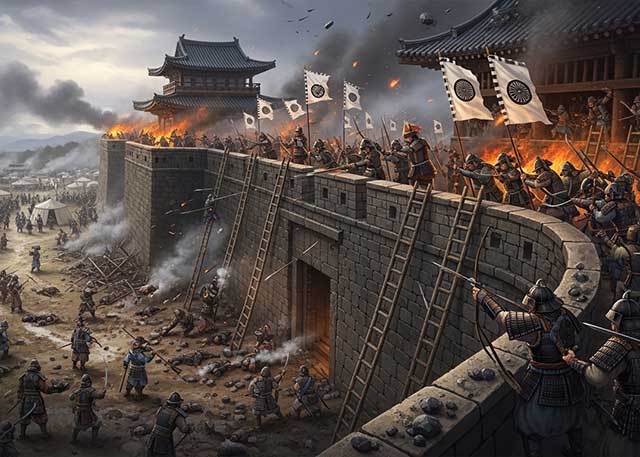
During the two Korean campaigns of the 16th century, the Japanese repeatedly had to capture enemy fortresses and defend occupied or constructed fortifications from the combined Korean and Chinese forces. Among all the operations of that time, the second siege of Jinju Castle is considered the most interesting from the point of view of siege warfare.
-
The Siege of Takamatsu Castle
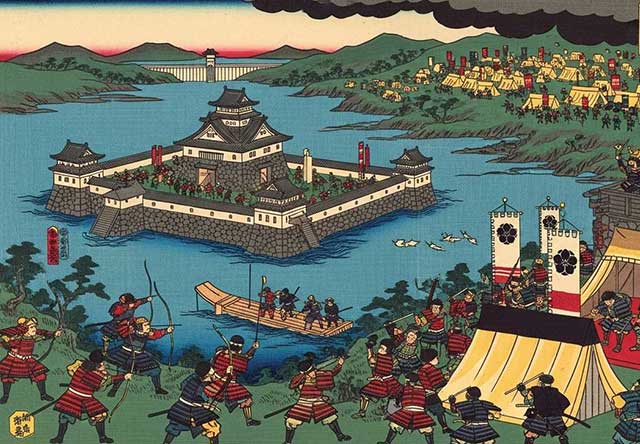
The siege of Takamatsu Castle in Bitchu Province is considered the first mizuzeme, or “water siege,” in Japanese history. Until then, such an original tactic had never been used.

